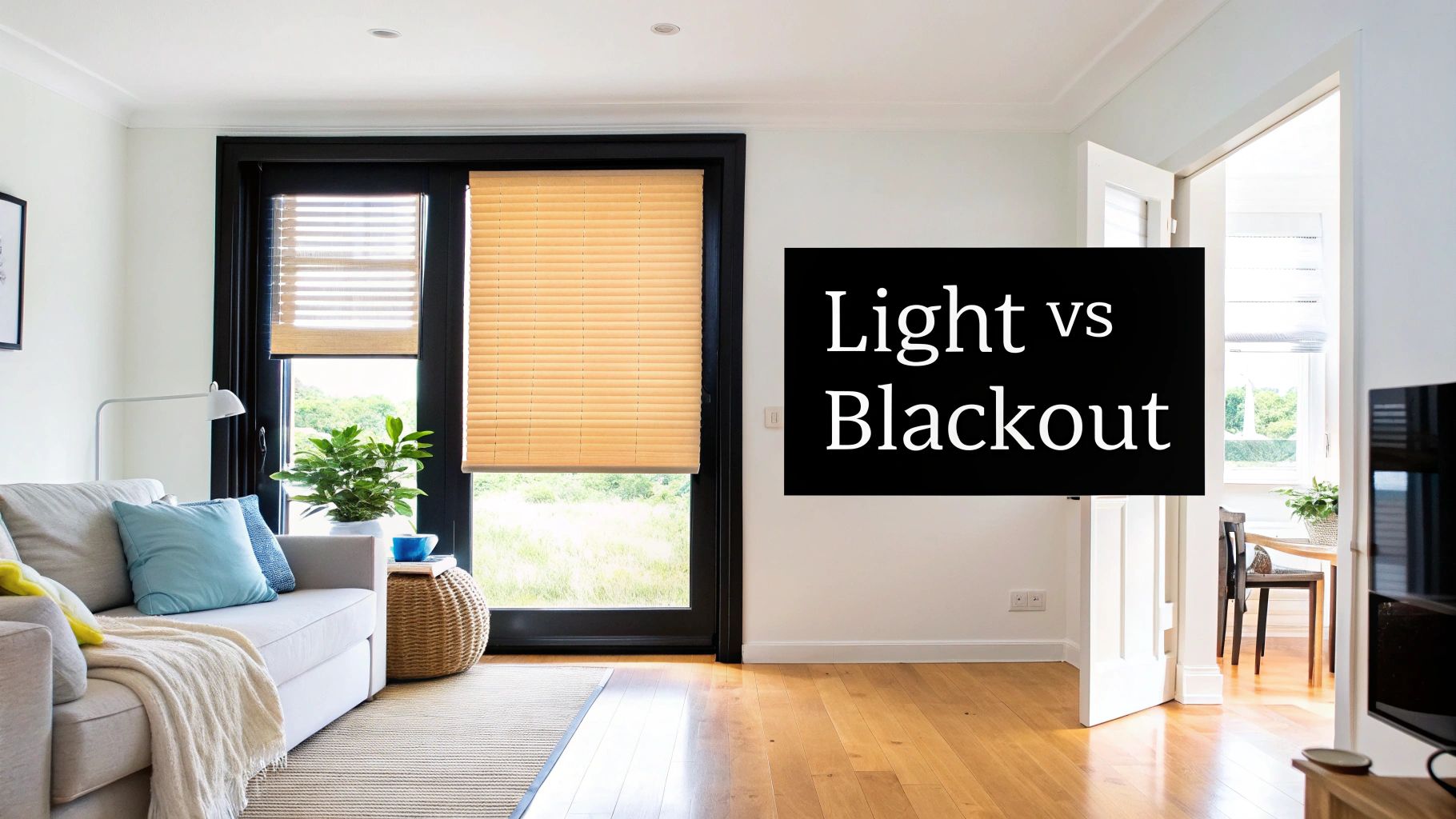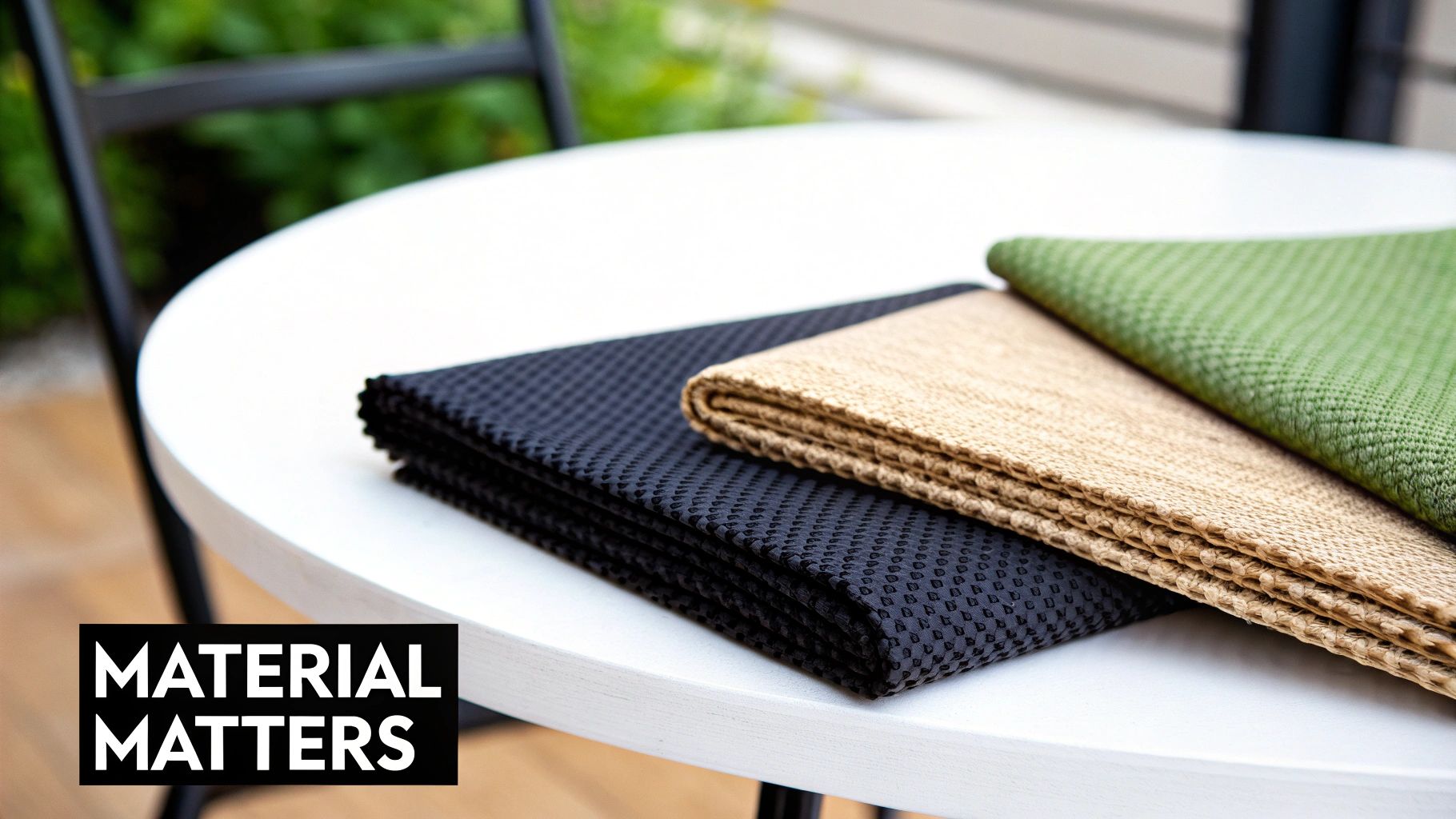
Light Filtering vs Blackout Shades: Which is Right For You?
Choosing between light filtering vs. blackout shades comes down to how you want a room to feel and function. The short answer is: light filtering shades gently diffuse sunlight to cut glare while keeping a room bright, making them ideal for living rooms and kitchens. Blackout shades are designed to block nearly all incoming light, offering total darkness and privacy—perfect for bedrooms and home theaters.
This guide will break down the key differences to help you make the perfect choice for every window in your home.
Table of Contents
- Choosing Your Ideal Window Treatment
- How Materials Control Light
- Core Differences: Light, Privacy, and Energy Savings
- Matching the Right Shade to Every Room
- Beyond Light: Sound Dampening and Design Aesthetics
- Making a Confident Purchase Decision
- Frequently Asked Questions
Choosing Your Ideal Window Treatment
Picking the right window treatment is a bigger deal than you might think. It’s not just about looks; it’s about setting the mood, controlling light, ensuring privacy, and even making your home more energy-efficient. This single choice shapes how you experience a room, from the soft morning light in your kitchen to the pitch-black needed for restful sleep.
When giving a room a makeover, deciding on window treatments early can make the whole process smoother. For help with the bigger picture, we recommend this a comprehensive guide on how to redecorate a room.

Light Filtering vs. Blackout: At a Glance
To make your decision easier, here's a simple table breaking down the key differences. Think of it as a quick cheat sheet to match your needs with the right shade.
| Feature | Light Filtering Shades | Blackout Shades |
|---|---|---|
| Primary Goal | Soften and diffuse natural light | Block nearly all external light |
| Light Blockage | Partial (reduces glare) | 95-99%+ |
| Best For | Living rooms, kitchens, offices | Bedrooms, nurseries, home theaters |
| Daytime Privacy | Excellent | Complete |
| Nighttime Privacy | Limited (silhouettes visible) | Complete |
| Energy Efficiency | Moderate UV protection | High (thermal insulation) |
| Atmosphere | Bright, airy, and welcoming | Dark, private, and controlled |
This table captures why people choose one over the other. Light filtering shades are a consistent favorite for common areas where you want pleasant, natural light. Meanwhile, blackout solutions are the undisputed champions for bedrooms and media rooms, where blocking nearly 100% of light is non-negotiable for rest or entertainment.
Understanding How Materials Control Light
The real difference in the light filtering vs. blackout debate comes down to how they’re made—specifically, the fabrics and layering. It’s a tale of two constructions.
Light filtering shades use a single layer of fabric designed to gently diffuse sunlight. In contrast, blackout shades are built with multi-layered cores engineered to stop light in its tracks.

Light Filtering Fabric Construction
Light filtering shades often use inviting materials like polyester or linen blends. The magic is in the weave. The density of that weave determines the shade's opacity, how much privacy it offers, and how well it reduces UV rays. A tighter weave can block 40-60% of incoming light, cutting glare while keeping the room bright.
- Woven Fabrics: These single-layer textiles soften and scatter sunlight, creating a warm, welcoming glow.
- Opacity Levels: Measured by the tightness of the weave, offering different levels of light diffusion.
- Privacy Factor: They provide great daytime privacy, though you might see silhouettes at night when indoor lights are on.
Blackout Fabric Construction
Blackout shades are all about complete light control. They usually feature an inner core or a foam layer sandwiched between fabrics. This core, often made of acrylic or foam, is the powerhouse that achieves 95-99% light blockage when installed properly.
- Decorative Outer Layer: The stylish side that matches your decor, so you never sacrifice style for function.
- Opaque Core: Made from acrylic or foam, this is the layer that blocks nearly all light.
- Protective Backing: Adds durability and acts as a final barrier to prevent any light from seeping through.
This layered construction does more than just block light; it also improves your home's energy efficiency. For those who love modern tech, innovations like electrochromic glass film even offer adjustable light control on demand.
If you’d like to get into the nitty-gritty of fabric science, our article on the science behind light filtering curtains is a great read.
Core Differences: Light, Privacy, and Energy Savings
When you compare light filtering vs. blackout shades, it helps to look at how they perform in three key areas: light control, privacy, and energy savings.
The Nuances of Light Control
Light filtering shades act like a soft diffuser for your windows, taming harsh sunlight into a pleasant, ambient glow. They are masters at reducing glare while still letting you enjoy a bright, naturally lit space.
- UV Ray Blockage: A quality light filtering shade blocks 40-60% of damaging UV rays, protecting furniture and floors from fading.
- Glare Reduction: They are a lifesaver in home offices or living rooms, cutting frustrating screen glare.
Blackout shades take a no-compromise approach. Their dense, multi-layered fabric is engineered to block over 99% of incoming light, making them the champion for creating a perfect sleep environment.
A Tale of Two Privacies
Privacy is another area where these two shades perform differently, especially from day to night. Both options obscure the view into your home during the daytime. However, the story changes once the sun goes down.
- Light Filtering at Night: When it's dark out and your lights are on, light filtering shades will show silhouettes and shadows to anyone looking in.
- Blackout at Night: Blackout shades provide complete and total privacy, 24/7. Their opaque material ensures nothing is visible from the outside.
The Impact on Your Energy Bills
A shade's construction directly impacts how well it insulates your windows. Blackout shades are the clear winner here. Their dense, multi-layered design creates a thermal barrier that makes a real difference.
- Summer Savings: They can reduce heat gain through your windows by up to 33%, helping keep rooms cooler.
- Winter Savings: In colder weather, they act like a blanket over the glass, preventing indoor heat from escaping.
This energy-saving feature is a big reason the global market for blackout fabrics is growing, hitting around USD 10.45 billion in 2024, according to a report from imarcgroup.com.
Matching the Right Shade to Every Room
The best window treatment isn't a one-size-fits-all decision. The right choice depends on how you use each room. Let's match the perfect shade to every space in your home.
Living Room and Home Office
For bright, airy spaces where you spend your days, you want to invite in natural light without the harsh glare.
- What to use: Light filtering shades.
- Why it works: They create a bright, welcoming atmosphere, cut screen glare by up to 60%, and block harmful UV rays to prevent furniture from fading.
- Pro Tip: Placing a light filtering shade in a south-facing window is a great trick for balancing light throughout the day. Check out our Living Room Collection for inspiration.
Bedroom and Nursery
When it comes to bedrooms and nurseries, creating a sanctuary for sleep is the top priority. This is where blackout shades truly shine.
- What to use: Blackout shades.
- Why it works: They deliver nearly 100% darkness, which is essential for supporting healthy sleep cycles. The blackout curtains market was valued at USD 1.68 billion in 2020 for a reason—people prioritize better sleep. Read more about blackout market insights.
- Pro Tip: For a baby's nap schedule, total darkness can be a game-changer, potentially reducing night waking.
Media Rooms and Multi-Purpose Spaces
For a true home theater experience, complete darkness is non-negotiable. Blackout shades eliminate all screen glare, creating an immersive, cinema-like environment.
- What to use: Blackout shades or a dual shade system.
- Why it works: Dual shades offer the best of both worlds: a light filtering layer for daytime use and a separate blackout backing for when you need total darkness.
- Pro Tip: This is the ultimate flexible solution for multi-purpose rooms. Explore our Dual Shade Systems to see how streamlined this setup can be.
Shade Selection Decision Tree
Feeling a bit overwhelmed? This simple decision tree can help guide you to the right shade based on what your room needs most.

As the infographic shows, it’s all about matching the function to the room. Light filtering shades are a natural fit for living areas, while blackout options are the clear winner for bedrooms and media spaces.
Beyond Light: Sound Dampening and Design Aesthetics
When we talk about light filtering vs. blackout shades, the conversation usually focuses on light. But your window treatments also play a huge part in your home's acoustics and overall style.
The Acoustic Edge of Blackout Shades
The dense, multi-layered construction of blackout shades gives them a surprising secondary benefit: they can dampen sound. While not a full soundproofing solution, their thickness helps muffle outside noise, making them great for bedrooms facing a busy street.
Some studies suggest that well-fitted cellular blackout shades can reduce perceived noise by 20–30%. If you're really looking to quiet your space, you can learn more about the best noise-reducing curtains.
The Airy Aesthetic of Light Filtering Shades
From a design standpoint, light filtering shades are all about creating a soft, airy, and welcoming vibe. They diffuse harsh sunlight, casting a gentle glow that makes any room feel more inviting.
- Texture and Material: Available in a huge variety of textures, from linen-like weaves to smooth polyesters, they complement any decor style.
- Layering Potential: Their lightweight nature is perfect for layering with heavier drapes for a more dimensional look.
Blackout Shades Have Evolved
Not too long ago, blackout shades were seen as purely functional. Thankfully, that’s completely changed. Modern manufacturing allows the light-blocking core to be separate from the decorative fabric facing your room.
This means you can now find blackout shades in a massive array of stylish colors, patterns, and textures—even crisp whites and soft pastels. They can be a bold design statement or a subtle backdrop in any room.
Making a Confident Purchase Decision
Deciding between light-filtering and blackout window treatments can feel overwhelming. This final section is a hands-on buyer’s guide to help you choose with confidence.
Key Purchase Checklist
- Precise Measurements: Capture the exact height and width of each window to eliminate light leaks.
- Mount Choice: Inside mounts deliver a sleek look; outside mounts wrap the frame for full coverage.
- Material Durability: Evaluate fabric strength, colorfastness, and cleaning requirements.
- Motorization Options: Decide between cordless, battery-powered, or smart shades.
- Fabric Swatches: Order samples to see how color and texture perform in your room's light.
- Room Goals: Clarify if you need soft daylight, total darkness, or better insulation.
Inside Mount vs. Outside Mount
An inside mount fits within the window frame for a minimalist vibe, though small gaps can let in stray light. An outside mount extends beyond the trim, sealing out light more effectively but requiring extra wall space.
| Mount Type | Pros | Cons |
|---|---|---|
| Inside Mount | Clean profile, saves trim space | Possible light gaps |
| Outside Mount | Maximum coverage, tight seal | Requires extra clearance |
Ordering Fabric Swatches
Sampling fabrics in your own lighting is a game changer. Order swatches and inspect them under both natural daylight and artificial light. This simple step prevents surprises and ensures the color and opacity match your vision.
Final Installation Tips
Proper installation is the final step. A perfect fit makes all the difference.
- Measure carefully to avoid light leaks around the edges.
- For total blackout, an outside mount often works best.
- For a dedicated media room, add side channels to completely seal out light.
For more detailed instructions, visit our Shade Installation Guide. And for more in-depth material details, check out our complete guide to blackout cloth fabric.
Frequently Asked Questions
Still weighing the choice between light filtering vs. blackout shades? Here are answers to some of the most common questions our customers ask.
Can People See Through Light Filtering Shades At Night?
Yes, to some extent. Light filtering shades are fantastic for daytime privacy, but when your lights are on inside and it’s dark out, people can often see shadows and silhouettes. For bedrooms and bathrooms where total privacy is a must, blackout shades are the clear winner, as they block both light and visibility completely.
Do Blackout Shades Have to Be A Dark Color?
No, and that’s one of the biggest myths! The power of a blackout shade comes from its dense inner core or opaque backing, not the color of the fabric you see. This means you can pick from a huge range of colors, including white or cream, to match your decor perfectly without giving up any light-blocking performance.
Can I Use Both Light Filtering and Blackout Shades on One Window?
Absolutely! Layering both types is a popular and practical solution, often called a "day-night" or "dual shade" system. This setup uses two separate shades on a single bracket, giving you three distinct options:
- Light Filtering: For soft, diffused natural light during the day.
- Blackout: For complete darkness when sleeping or watching movies.
- Fully Open: To enjoy an unobstructed view and maximum sunlight.
This versatile system truly gives you the best of both worlds, adapting to your needs any time of day.
Ready to find the perfect window treatment that balances style, function, and your budget? Explore the full collection at Joey'z Shopping and discover high-quality options for every room in your home.
